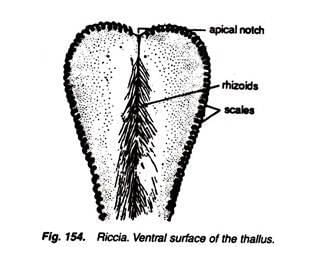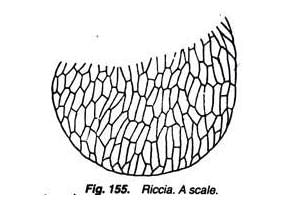NEET Exam > NEET Questions > Which of the following type of scales are fou...
Start Learning for Free
Which of the following type of scales are found in Riccia-
- a)Multicelled and ligulate
- b)Multicelled and appendiculate
- c)Unicelled and appendiculate
- d)Unicelled and ligulate
Correct answer is option 'A'. Can you explain this answer?
Verified Answer
Which of the following type of scales are found in Riccia-a)Multicelle...
Ans.
In Ventral Surface:
Scales and rhizoids (Fig. 154) are present.

Ventral Surface of the Thallus
Scales:
1. These are generally present (Fig. 154) on the margins in one row, or near the growing points.
ADVERTISEMENTS:
2. Scales are multicellular but one-celled thick structures (Fig. 155).
Riccia

3. The colour of the scales is violet.
4. Function of scales is to protect the young growing points.
Scales and rhizoids (Fig. 154) are present.

Ventral Surface of the Thallus
Scales:
1. These are generally present (Fig. 154) on the margins in one row, or near the growing points.
ADVERTISEMENTS:
2. Scales are multicellular but one-celled thick structures (Fig. 155).
Riccia

3. The colour of the scales is violet.
4. Function of scales is to protect the young growing points.
Most Upvoted Answer
Which of the following type of scales are found in Riccia-a)Multicelle...
Riccia is a genus of liverworts, which are small, non-vascular plants that belong to the division Marchantiophyta. Liverworts, including Riccia, have a simple thallus structure, which consists of a flat, ribbon-like body. The thallus is composed of cells and may have different types of scales that provide protection and aid in various functions. Among the options provided, the correct type of scales found in Riccia is multicelled and ligulate.
Explanation:
1. Liverwort structure:
Liverworts, including Riccia, have a thallus structure, which is a flattened body that lacks true roots, stems, and leaves. The thallus is composed of cells and can vary in shape and size.
2. Scales in Riccia:
Scales are small structures found on the surface of the thallus in liverworts. They serve various functions, including protection against desiccation, herbivory, and UV radiation.
3. Multicelled scales:
Multicelled scales are composed of multiple cells. These scales can be found on the thallus of Riccia. The multicelled scales in Riccia are typically elongated and narrow, resembling a tongue or strap-like structure.
4. Ligulate scales:
Ligulate scales are scales that are tongue-like or strap-like in shape. They are often elongated and narrow. These scales can be found on the thallus of Riccia.
5. Unicelled scales:
Unicelled scales are scales composed of a single cell. These scales are not found in Riccia.
Conclusion:
In summary, the correct type of scales found in Riccia is multicelled and ligulate. These scales are elongated and narrow, resembling a tongue or strap-like structure. They serve various functions, including protection against desiccation and herbivory.
Explanation:
1. Liverwort structure:
Liverworts, including Riccia, have a thallus structure, which is a flattened body that lacks true roots, stems, and leaves. The thallus is composed of cells and can vary in shape and size.
2. Scales in Riccia:
Scales are small structures found on the surface of the thallus in liverworts. They serve various functions, including protection against desiccation, herbivory, and UV radiation.
3. Multicelled scales:
Multicelled scales are composed of multiple cells. These scales can be found on the thallus of Riccia. The multicelled scales in Riccia are typically elongated and narrow, resembling a tongue or strap-like structure.
4. Ligulate scales:
Ligulate scales are scales that are tongue-like or strap-like in shape. They are often elongated and narrow. These scales can be found on the thallus of Riccia.
5. Unicelled scales:
Unicelled scales are scales composed of a single cell. These scales are not found in Riccia.
Conclusion:
In summary, the correct type of scales found in Riccia is multicelled and ligulate. These scales are elongated and narrow, resembling a tongue or strap-like structure. They serve various functions, including protection against desiccation and herbivory.

|
Explore Courses for NEET exam
|

|
Similar NEET Doubts
Which of the following type of scales are found in Riccia-a)Multicelled and ligulateb)Multicelled and appendiculatec)Unicelled and appendiculated)Unicelled and ligulateCorrect answer is option 'A'. Can you explain this answer?
Question Description
Which of the following type of scales are found in Riccia-a)Multicelled and ligulateb)Multicelled and appendiculatec)Unicelled and appendiculated)Unicelled and ligulateCorrect answer is option 'A'. Can you explain this answer? for NEET 2025 is part of NEET preparation. The Question and answers have been prepared according to the NEET exam syllabus. Information about Which of the following type of scales are found in Riccia-a)Multicelled and ligulateb)Multicelled and appendiculatec)Unicelled and appendiculated)Unicelled and ligulateCorrect answer is option 'A'. Can you explain this answer? covers all topics & solutions for NEET 2025 Exam. Find important definitions, questions, meanings, examples, exercises and tests below for Which of the following type of scales are found in Riccia-a)Multicelled and ligulateb)Multicelled and appendiculatec)Unicelled and appendiculated)Unicelled and ligulateCorrect answer is option 'A'. Can you explain this answer?.
Which of the following type of scales are found in Riccia-a)Multicelled and ligulateb)Multicelled and appendiculatec)Unicelled and appendiculated)Unicelled and ligulateCorrect answer is option 'A'. Can you explain this answer? for NEET 2025 is part of NEET preparation. The Question and answers have been prepared according to the NEET exam syllabus. Information about Which of the following type of scales are found in Riccia-a)Multicelled and ligulateb)Multicelled and appendiculatec)Unicelled and appendiculated)Unicelled and ligulateCorrect answer is option 'A'. Can you explain this answer? covers all topics & solutions for NEET 2025 Exam. Find important definitions, questions, meanings, examples, exercises and tests below for Which of the following type of scales are found in Riccia-a)Multicelled and ligulateb)Multicelled and appendiculatec)Unicelled and appendiculated)Unicelled and ligulateCorrect answer is option 'A'. Can you explain this answer?.
Solutions for Which of the following type of scales are found in Riccia-a)Multicelled and ligulateb)Multicelled and appendiculatec)Unicelled and appendiculated)Unicelled and ligulateCorrect answer is option 'A'. Can you explain this answer? in English & in Hindi are available as part of our courses for NEET.
Download more important topics, notes, lectures and mock test series for NEET Exam by signing up for free.
Here you can find the meaning of Which of the following type of scales are found in Riccia-a)Multicelled and ligulateb)Multicelled and appendiculatec)Unicelled and appendiculated)Unicelled and ligulateCorrect answer is option 'A'. Can you explain this answer? defined & explained in the simplest way possible. Besides giving the explanation of
Which of the following type of scales are found in Riccia-a)Multicelled and ligulateb)Multicelled and appendiculatec)Unicelled and appendiculated)Unicelled and ligulateCorrect answer is option 'A'. Can you explain this answer?, a detailed solution for Which of the following type of scales are found in Riccia-a)Multicelled and ligulateb)Multicelled and appendiculatec)Unicelled and appendiculated)Unicelled and ligulateCorrect answer is option 'A'. Can you explain this answer? has been provided alongside types of Which of the following type of scales are found in Riccia-a)Multicelled and ligulateb)Multicelled and appendiculatec)Unicelled and appendiculated)Unicelled and ligulateCorrect answer is option 'A'. Can you explain this answer? theory, EduRev gives you an
ample number of questions to practice Which of the following type of scales are found in Riccia-a)Multicelled and ligulateb)Multicelled and appendiculatec)Unicelled and appendiculated)Unicelled and ligulateCorrect answer is option 'A'. Can you explain this answer? tests, examples and also practice NEET tests.

|
Explore Courses for NEET exam
|

|
Signup for Free!
Signup to see your scores go up within 7 days! Learn & Practice with 1000+ FREE Notes, Videos & Tests.
























